Caryn
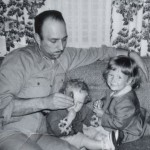
 I’m sure that everyone has heard the little jokes people make to tease someone about which parent they look like…or sometimes don’t. They might say something like, “You look like the milkman.” Of course, the indication is that the mother had an affair, but sometimes such a joke can backfire on the teller of the joke. When I say this, I am speaking from experience…not as an adult, but rather as a child. You see, my sister, Cheryl Masterson and I do look like the milk man…because the milkman was our dad. Of course our younger sisters do too, but he wasn’t a milk man when they were born.
I’m sure that everyone has heard the little jokes people make to tease someone about which parent they look like…or sometimes don’t. They might say something like, “You look like the milkman.” Of course, the indication is that the mother had an affair, but sometimes such a joke can backfire on the teller of the joke. When I say this, I am speaking from experience…not as an adult, but rather as a child. You see, my sister, Cheryl Masterson and I do look like the milk man…because the milkman was our dad. Of course our younger sisters do too, but he wasn’t a milk man when they were born.
During the early years of their marriage, my dad worked for a company called Twin Ports Dairy, in Superior, Wisconsin. Over the remaining years of his life, my dad held various other jobs, and the one I remember the best was when he was a welder, first for Fred Dewell company, and later for WOTCO. Both of these were in Casper, Wyoming. One of the ones that I found the most interesting was when he worked for Douglas Aircraft. This was before he was married, and before World War II. It was this job that qualified him to become the  Flight Engineer on the B-17 Bomber. A man who worked building airplanes, would have a unique ability in that field. He also did work in the lumber yards and in the oil fields, prior to my parents marriage. In fact, he was working in the oil fields when he and my mother exchanged their wonderful love letters…which my sisters and I recently came across among their things. There are many parts to a man, and most men will do several types of work before settling on the one they will do for the rest of their life. My dad was no different, but in the end it would be the work that he did at the suggestion of his older brother, my Uncle Bill, that my dad would do the longest…welding. As World War II was progressing to the point of Americas necessary involvement, Uncle Bill was worried about his little brother, and he really hoped that his skill as a welder would keep my Dad on the home front, but it was his skill with airplanes that would win out in the end, and Dad would go to war…and thankfully come back home again.
Flight Engineer on the B-17 Bomber. A man who worked building airplanes, would have a unique ability in that field. He also did work in the lumber yards and in the oil fields, prior to my parents marriage. In fact, he was working in the oil fields when he and my mother exchanged their wonderful love letters…which my sisters and I recently came across among their things. There are many parts to a man, and most men will do several types of work before settling on the one they will do for the rest of their life. My dad was no different, but in the end it would be the work that he did at the suggestion of his older brother, my Uncle Bill, that my dad would do the longest…welding. As World War II was progressing to the point of Americas necessary involvement, Uncle Bill was worried about his little brother, and he really hoped that his skill as a welder would keep my Dad on the home front, but it was his skill with airplanes that would win out in the end, and Dad would go to war…and thankfully come back home again.
All those parts of my dad…along with his deep love of family would make him into the person we all knew and dearly loved, but I think for my mom, its possible that the Milkman job was a personal favorite. After all, it kept 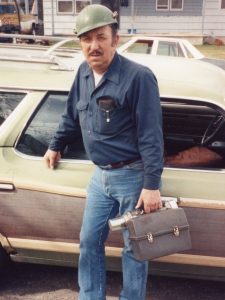
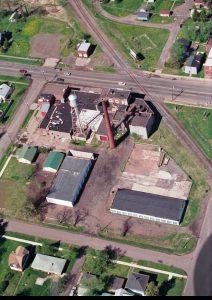 him close to home, and it was a safe job for her husband and the father of her children. I think it was her favorite, because of all the times I have heard her talk about that one, and I can relate to the part about keeping him home, because sometimes when he had to go out of town for work in the years after we moved to Casper, I simply didn’t feel good until he came home. I don’t mean sad…I mean I felt physically ill until he came home. My sisters and I loved our daddy very much, and we wanted him to be at home. In fact, I still wish he was at home…here on Earth, instead of in Heaven, because I miss him very much. Today would have been my dad’s 93rd birthday. Happy birthday in Heaven Dad. We all love and miss you very much, and can’t wait to see you and Mom again.
him close to home, and it was a safe job for her husband and the father of her children. I think it was her favorite, because of all the times I have heard her talk about that one, and I can relate to the part about keeping him home, because sometimes when he had to go out of town for work in the years after we moved to Casper, I simply didn’t feel good until he came home. I don’t mean sad…I mean I felt physically ill until he came home. My sisters and I loved our daddy very much, and we wanted him to be at home. In fact, I still wish he was at home…here on Earth, instead of in Heaven, because I miss him very much. Today would have been my dad’s 93rd birthday. Happy birthday in Heaven Dad. We all love and miss you very much, and can’t wait to see you and Mom again.

 My grand nephew, Zackery Spethman is turning 12 today. It is his last pre-teen year, and I can hardly believe how quickly the time has flown by. Zack is such a loving young man. His kind heart shows in everything he does. He helps those in need and shows kindness to everyone around him. One thing that always comes to my mind, as his great aunt, is the fact that Zack is quick to give me a hug whenever he sees me. That may seem like a little thing to most people, and even to Zack, but it is a big deal to a great aunt. Kids are often distant with the older aunts, but Zack always makes me feel loved.
My grand nephew, Zackery Spethman is turning 12 today. It is his last pre-teen year, and I can hardly believe how quickly the time has flown by. Zack is such a loving young man. His kind heart shows in everything he does. He helps those in need and shows kindness to everyone around him. One thing that always comes to my mind, as his great aunt, is the fact that Zack is quick to give me a hug whenever he sees me. That may seem like a little thing to most people, and even to Zack, but it is a big deal to a great aunt. Kids are often distant with the older aunts, but Zack always makes me feel loved.
 This year will be Zack’s last year in elementary school, and for his mother, my niece, Jenny Spethman, that is the really hard. The years have flown by so fast, and she can see the future going by even faster. She has tried to make sure that they attend every play, recital, and game he is involved in this year, knowing that in just a little over a month, Zack will have graduated to middle school. Zack plays the Saxophone in band, and really likes it. In the world of instruments, that is one of the coolest. I could never have played that one, because you have to be able to make it sound like something other than a sick duck, and I couldn’t, but Zack can, and he does it very well.
This year will be Zack’s last year in elementary school, and for his mother, my niece, Jenny Spethman, that is the really hard. The years have flown by so fast, and she can see the future going by even faster. She has tried to make sure that they attend every play, recital, and game he is involved in this year, knowing that in just a little over a month, Zack will have graduated to middle school. Zack plays the Saxophone in band, and really likes it. In the world of instruments, that is one of the coolest. I could never have played that one, because you have to be able to make it sound like something other than a sick duck, and I couldn’t, but Zack can, and he does it very well.
Zack’s horizons are broadening in so many ways now, and one of the most exciting ones for him is that this year he will get to go hunting with his dad and brother, Xander. For the Spethman children, going hunting is a 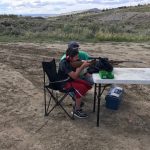
 rite of passage. They have all learned to shoot and be responsible with guns at very young ages, and from what Zack’s dad, Steve Spethman tells me, Zack is a pretty good shot. As we all know, practice makes perfect, and Zack loves to go practice shooting. I know that Zack will be a good hunter, and will feel good about being able to bring home meat for the family. That is something that makes a man feel successful, and Zack is successful at everything he does. Today is Zack’s 12th birthday. Happy birthday Zack!! Have a great day!! We love you!!
rite of passage. They have all learned to shoot and be responsible with guns at very young ages, and from what Zack’s dad, Steve Spethman tells me, Zack is a pretty good shot. As we all know, practice makes perfect, and Zack loves to go practice shooting. I know that Zack will be a good hunter, and will feel good about being able to bring home meat for the family. That is something that makes a man feel successful, and Zack is successful at everything he does. Today is Zack’s 12th birthday. Happy birthday Zack!! Have a great day!! We love you!!

 There really is no better day in a family, than when a new baby arrives. Yesterday was just such a day for my nephew, Eric Parmely, his wife Ashley, and their daughters, Reagan and Hattie. Yesterday was the day that someone new arrived. His name is Bowen Lewis Parmely, and he made his appearance three weeks early, because his doctors felt that it would be best for him. He was a big baby boy, weighing in at 8 pounds 7.5 ounces, and he was 21¼ inches long…and everything with mommy and baby Bowen is perfect…including his appetite. Bowen is the first son for his parents, and the first grandson for his grandparents, and everyone is just as happy as they can be. He is also the first, and maybe only brother for his two big sisters, who cant wait until he can play.
There really is no better day in a family, than when a new baby arrives. Yesterday was just such a day for my nephew, Eric Parmely, his wife Ashley, and their daughters, Reagan and Hattie. Yesterday was the day that someone new arrived. His name is Bowen Lewis Parmely, and he made his appearance three weeks early, because his doctors felt that it would be best for him. He was a big baby boy, weighing in at 8 pounds 7.5 ounces, and he was 21¼ inches long…and everything with mommy and baby Bowen is perfect…including his appetite. Bowen is the first son for his parents, and the first grandson for his grandparents, and everyone is just as happy as they can be. He is also the first, and maybe only brother for his two big sisters, who cant wait until he can play.
As for Bowen…well, his first day was a very busy one. He was born at 8:56pm on April 24th…just when a guy should be 
 sleeping, and they were shining bright lights in his face. Nevertheless, Bowen took it all in stride. He was handed off, first to his parents, and then to the grandparents. I’m sure he wondered how a guy could go about getting a bath around that place, but he waited patiently, and pretty soon they got him cleaned up and dressed so that he could meet his sisters…the most important people in his immediate life…after his parents that is. After all, it will be his sisters who play with him, teach him the ropes…on how to get around Mom and Dad, babysit him, and in probably, boss him around a lot. But, in all reality, while his sisters said that they wanted another sister, all that changed when they saw their brother. All thought a of a sister went out the door. Who could blame them? Little Bowen is a perfectly handsome little man, and the girls developed instant Brother Love!!
sleeping, and they were shining bright lights in his face. Nevertheless, Bowen took it all in stride. He was handed off, first to his parents, and then to the grandparents. I’m sure he wondered how a guy could go about getting a bath around that place, but he waited patiently, and pretty soon they got him cleaned up and dressed so that he could meet his sisters…the most important people in his immediate life…after his parents that is. After all, it will be his sisters who play with him, teach him the ropes…on how to get around Mom and Dad, babysit him, and in probably, boss him around a lot. But, in all reality, while his sisters said that they wanted another sister, all that changed when they saw their brother. All thought a of a sister went out the door. Who could blame them? Little Bowen is a perfectly handsome little man, and the girls developed instant Brother Love!!

 Bowen’s grandparents, like his parents, aunts, uncles, and the rest of the family, are all floating on air, now that he has arrived. Sometimes, I wonder how nine months can seem so long. When we first found out that baby Bowen was coming, and especially when we found out that he was a boy, we were all very excited. Now that he is here, the excitement is just growing. As for little Bowen, I think he figures that the future can wait for a while, because all these visitors have completely worn him out. Congratulations to Eric and Ashley Parmely. Your son is so cute. Love you guys.
Bowen’s grandparents, like his parents, aunts, uncles, and the rest of the family, are all floating on air, now that he has arrived. Sometimes, I wonder how nine months can seem so long. When we first found out that baby Bowen was coming, and especially when we found out that he was a boy, we were all very excited. Now that he is here, the excitement is just growing. As for little Bowen, I think he figures that the future can wait for a while, because all these visitors have completely worn him out. Congratulations to Eric and Ashley Parmely. Your son is so cute. Love you guys.
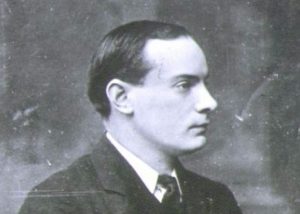
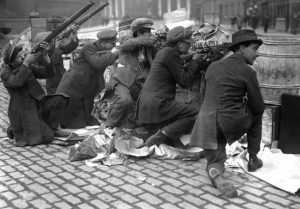 Because my family has some history in England and Ireland, the history of that area holds an interest for me. Through my DNA, I have found out that much of the family I previously thought of as English, actually originated in France. Nevertheless, they spent the majority of the centuries in England and Ireland. That said, the feuds between the two nations have been as interesting to me as the Revolutionary War. I suppose that when a nation turns an area into a territory, and then that area decides to become it’s own nation, there can be a bit of an uproar…to put it mildly. The parent nation is usually very much against the independence of the child nation…for lack of a better word.
Because my family has some history in England and Ireland, the history of that area holds an interest for me. Through my DNA, I have found out that much of the family I previously thought of as English, actually originated in France. Nevertheless, they spent the majority of the centuries in England and Ireland. That said, the feuds between the two nations have been as interesting to me as the Revolutionary War. I suppose that when a nation turns an area into a territory, and then that area decides to become it’s own nation, there can be a bit of an uproar…to put it mildly. The parent nation is usually very much against the independence of the child nation…for lack of a better word.
It was on April 24, 1916…Easter Monday, that the Irish Republican Brotherhood, which was a secret organization of Irish nationalists led by Patrick Pearse, launched the so-called Easter Rebellion in Dublin. It was an armed uprising against British rule. The Brotherhood was assisted by militant Irish socialists under James Connolly. Pearse and his fellow Republicans rioted and attacked British provincial government headquarters across Dublin and seized the Irish capital’s General Post Office. After their quick initial success, they proclaimed the independence of Ireland, and by morning they controlled much of the city of Dublin. They were fighting against the repressive government of the United Kingdom that they had been under for centuries. Their hopes of freedom were dashed later the next day when the British authorities launched a counterattack. By April 29th, it was all over. The uprising had been crushed. Nevertheless, the Easter Rebellion is considered a significant marker on the road to establishing an independent Irish republic.
Following the uprising, Pearse and 14 other nationalist leaders were executed for their participation, but they were held up as martyrs by many in Ireland. There was a lot of anger among most Irish people for the British, who had enacted a series of harsh anti-Catholic restrictions, the Penal Laws, in the 18th century, and then let 1.5 million Irish starve during the Potato Famine of 1845-1848. Armed protest continued after the Easter Rebellion and in 1921, 26 of Ireland’s 32 counties won independence with the declaration of the Irish Free State. The Free State became an independent republic in 1949. However, six northeastern counties of the Emerald Isle remained part of the United Kingdom. This prompted some nationalists to reorganize themselves into the Irish Republican Army (IRA) to continue their struggle for full Irish independence.
In the late 1960s, spurred on in part by the United States civil rights movement, Catholics in Northern Ireland, who had long been discriminated against by British policies that favored Irish Protestants, advocated for justice. Riots broke out between Catholics and Protestants in the region and the violence escalated as the pro-Catholic IRA battled British troops. Most people have heard about this struggle over the years. An ongoing series of terrorist bombings and attacks ensued in a drawn-out conflict that came to be known as “The Troubles.” Peace talks 
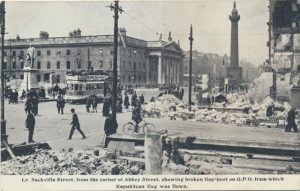 eventually took place throughout the mid to late 1990s, but a permanent end to the violence remained elusive, until July 2005, when IRA finally announced that its members would give up all their weapons and would pursue the group’s objectives solely through peaceful means. By the fall of 2006, the Independent Monitoring Commission reported that the IRA’s military campaign to end British rule was over.
eventually took place throughout the mid to late 1990s, but a permanent end to the violence remained elusive, until July 2005, when IRA finally announced that its members would give up all their weapons and would pursue the group’s objectives solely through peaceful means. By the fall of 2006, the Independent Monitoring Commission reported that the IRA’s military campaign to end British rule was over.
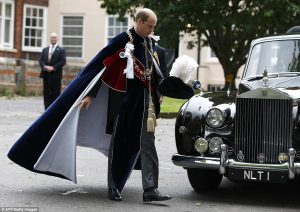 On this day, April 23, 1348, the Most Noble Order of the Garter…the first knighthood of England was founded. This knighthood is only inferior to the Victoria Cross and the George Cross. The honor is always bestowed on its winners on April 23, which is Saint George’s day. Saint George is England’s patron saint. Appointments are awarded at the Sovereign’s pleasure as a personal gift on recipients from the United Kingdom and other Commonwealth realms. Membership of the Order is limited to the Sovereign, the Prince of Wales, and no more than 24 members, or Companions. The order also includes supernumerary knights and ladies.
On this day, April 23, 1348, the Most Noble Order of the Garter…the first knighthood of England was founded. This knighthood is only inferior to the Victoria Cross and the George Cross. The honor is always bestowed on its winners on April 23, which is Saint George’s day. Saint George is England’s patron saint. Appointments are awarded at the Sovereign’s pleasure as a personal gift on recipients from the United Kingdom and other Commonwealth realms. Membership of the Order is limited to the Sovereign, the Prince of Wales, and no more than 24 members, or Companions. The order also includes supernumerary knights and ladies.
That made me wonder just exactly what it took to become a knight. It seems that in Medieval times, becoming a knight was something young men trained for from early childhood. 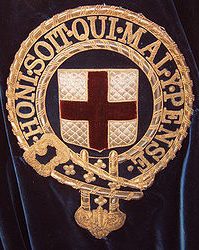 Knighthood training was a long and often arduous process. It began with a basic education and good manners and rules of etiquette were taught at home. At the age of seven, young boys were sent away to the castles and homes of wealthy lords or relatives to embark on their knighthood training. From the age of seven to fourteen these young boys were given the role of a Medieval Page. From fourteen to twenty-one these ‘apprentice knights’ were referred to as Squires. The different types and styles of Knighthood training depended on the age and strength of the apprentice knights. Knighthood training was focussed on weapon practice which included enhancing skills in horsemanship, the two-handed sword, battle axe, mace, dagger and lance. Still, it was not all the training that ultimately won the squire to coveted title of knight. A squire had to prove his bravery and skill at battle. Only then, would he become a knight…at the age of twenty-one. He gained the title of knight at a “dubbing” ceremony. All this was a really big deal.
Knighthood training was a long and often arduous process. It began with a basic education and good manners and rules of etiquette were taught at home. At the age of seven, young boys were sent away to the castles and homes of wealthy lords or relatives to embark on their knighthood training. From the age of seven to fourteen these young boys were given the role of a Medieval Page. From fourteen to twenty-one these ‘apprentice knights’ were referred to as Squires. The different types and styles of Knighthood training depended on the age and strength of the apprentice knights. Knighthood training was focussed on weapon practice which included enhancing skills in horsemanship, the two-handed sword, battle axe, mace, dagger and lance. Still, it was not all the training that ultimately won the squire to coveted title of knight. A squire had to prove his bravery and skill at battle. Only then, would he become a knight…at the age of twenty-one. He gained the title of knight at a “dubbing” ceremony. All this was a really big deal.
Knighthood, like all tradition has undergone changes over the centuries, and I’m sure most of us know that people like Paul McCartney, Elton John, and Mick Jagger have all been knighted. After researching the  requirements of old, I wondered how these men became knights. So, I looked into it, and I came back disappointed. It seems that these men were knighted for their work in music and charity. While these are noteworthy accomplishments, it seems to me that they could find a different type of award for these feats. How can work in music and charity possibly be as award worthy as bravery and skill in battle. That would be like giving the purple heart to someone who wrote a book about someone being injured in a war. I think David Bowie must have agreed with me, because in 2003, he turned down the knighthood offered to him. He was labeled a rebel, and it was thought that he was unimpressed with nobility, but maybe he just didn’t see how he could have earned it. I would agree.
requirements of old, I wondered how these men became knights. So, I looked into it, and I came back disappointed. It seems that these men were knighted for their work in music and charity. While these are noteworthy accomplishments, it seems to me that they could find a different type of award for these feats. How can work in music and charity possibly be as award worthy as bravery and skill in battle. That would be like giving the purple heart to someone who wrote a book about someone being injured in a war. I think David Bowie must have agreed with me, because in 2003, he turned down the knighthood offered to him. He was labeled a rebel, and it was thought that he was unimpressed with nobility, but maybe he just didn’t see how he could have earned it. I would agree.
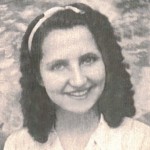 My Aunt Delores Byer Johnson was always the kind of person who brought sunshine with her into a room. She loved to make people laugh, and she didn’t mind being a little bit silly if it would brighten everyone’s day. My mom, Collene Byer Spencer used to tell me about all of the inventive ideas her sister used to come up with.
My Aunt Delores Byer Johnson was always the kind of person who brought sunshine with her into a room. She loved to make people laugh, and she didn’t mind being a little bit silly if it would brighten everyone’s day. My mom, Collene Byer Spencer used to tell me about all of the inventive ideas her sister used to come up with.
Mom used to tell me that with Aunt Dee is the house, there was never a dull moment. Aunt Dee might have been teaching the kids how to dance, or playing the piano she bought for the family, or teaching the kids how to fly…using a coat and the wind of course. It didn’t matter what scheme Aunt Dee had in mind, everyone knew it was going to be a lot of fun, because Aunt Dee made it fun. She had a way of doing that.
 Aunt Dee has been gone now for almost 21 years, I can still hear her laughter and see her smiling face, every time I think of her. She loved life, and she had such a zest for life. I suppose that is why I miss her so much. She loved spending time with her nieces and nephews, and never made us feel unimportant. When we were with her, we were important. Family was everything to her.
Aunt Dee has been gone now for almost 21 years, I can still hear her laughter and see her smiling face, every time I think of her. She loved life, and she had such a zest for life. I suppose that is why I miss her so much. She loved spending time with her nieces and nephews, and never made us feel unimportant. When we were with her, we were important. Family was everything to her.
In many ways, I think Aunt Dee was a kid at heart, and that was what always made her so much fun to be around. I will always miss that, and I can’t wait to see her again in Heaven. Today would have been Aunt Dee’s 86th birthday. Happy birthday in Heaven Aunt Dee. We all love you very much.
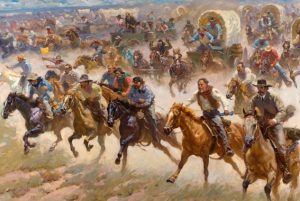 As Americans began to expand to the West, new territories had to be opened for settlement. Of course, this was not always met with approval from the Indian nations who were living there at the time. Nevertheless, the settling of this nation would not be stopped, and while it was handled wrong in many ways, it was inevitable. Nearly two million acres of land in Oklahoma Territory had been preciously deemed unsuitable for white settlement, and so were given to the Native Americans who had been previously removed from their traditional lands to allow for white settlement. The relocations began in 1817. By the 1880s, Indian Territory was home to a variety of tribes, including the Chickasaw, Choctaw, Cherokee, Creek, Cheyenne, Comanche, and Apache.
As Americans began to expand to the West, new territories had to be opened for settlement. Of course, this was not always met with approval from the Indian nations who were living there at the time. Nevertheless, the settling of this nation would not be stopped, and while it was handled wrong in many ways, it was inevitable. Nearly two million acres of land in Oklahoma Territory had been preciously deemed unsuitable for white settlement, and so were given to the Native Americans who had been previously removed from their traditional lands to allow for white settlement. The relocations began in 1817. By the 1880s, Indian Territory was home to a variety of tribes, including the Chickasaw, Choctaw, Cherokee, Creek, Cheyenne, Comanche, and Apache.
By the 1890s, with the improvements in agricultural and ranching techniques led some white Americans to realize that the Indian Territory land could be valuable, so they began to pressure the United States government to allow white settlement in the region. In 1889, President Benjamin Harrison agreed, making the first of a long series of authorizations that eventually removed most of Indian Territory from Indian control. To begin the process of white settlement, President Harrison chose to open a 1.9 million acre section of Indian Territory that the government had never assigned to any specific tribe. I suppose it was a way to ease into it without taking land from any specific tribe…initially anyway. However, subsequent openings of sections that 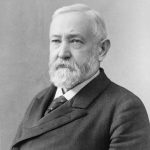 were designated to specific tribes were achieved primarily through the Dawes Severalty Act of 1887, which allowed whites to settle large swaths of land that had previously been designated to specific Indian tribes.
were designated to specific tribes were achieved primarily through the Dawes Severalty Act of 1887, which allowed whites to settle large swaths of land that had previously been designated to specific Indian tribes.
On March 3, 1889, Harrison announced the government would open the 1.9 million-acre tract of Indian Territory for settlement precisely at noon on April 22, 1889. Anyone could join the race for the land, but no one was supposed to jump the gun. With only seven weeks to prepare, the land-hungry Americans quickly began to gather around the borders of the irregular rectangle of territory. They were referred to as “Boomers,” and by the appointed day more than 50,000 hopefuls were living in tent cities on all four sides of the territory. At precisely high noon, thousands of would-be settlers make a mad dash into the newly opened Oklahoma Territory to claim cheap land. I can only imagine the chaos. The events that day at Fort Reno on the western border were typical of the entire process. At 11:50am, soldiers called for everyone to form a line. When the hands of the clock reached noon, the cannon of the fort boomed, and the soldiers signaled the settlers to start. With the crack of hundreds of whips, thousands of Boomers streamed into the territory in wagons, on horseback, and on foot. All told, from 50,000 to 60,000 settlers entered the territory that day. By nightfall, they had staked thousands of claims either on town lots or quarter section farm plots. Towns like Norman, Oklahoma City, Kingfisher, and Guthrie sprang into being almost overnight.
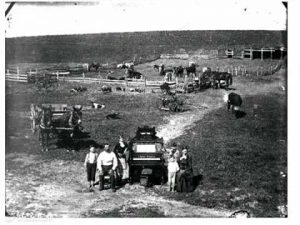 An extraordinary display of both the pioneer spirit and the American lust for land, the first Oklahoma land rush was also plagued by greed and fraud. Cases involving “Sooners,” who were people who had entered the territory before the legal date and time overloaded courts for years to come. I’m sure that the Indians weren’t pleased either, and I would imagine that there was periodic trouble over the whole process too. The government attempted to improve the operations of subsequent runs by adding more controls, finally adopting a lottery system to designate claims. By 1905, white Americans owned most of the land in Indian Territory. Two years later, the area once known as Indian Territory entered the Union as a part of the new state of Oklahoma.
An extraordinary display of both the pioneer spirit and the American lust for land, the first Oklahoma land rush was also plagued by greed and fraud. Cases involving “Sooners,” who were people who had entered the territory before the legal date and time overloaded courts for years to come. I’m sure that the Indians weren’t pleased either, and I would imagine that there was periodic trouble over the whole process too. The government attempted to improve the operations of subsequent runs by adding more controls, finally adopting a lottery system to designate claims. By 1905, white Americans owned most of the land in Indian Territory. Two years later, the area once known as Indian Territory entered the Union as a part of the new state of Oklahoma.
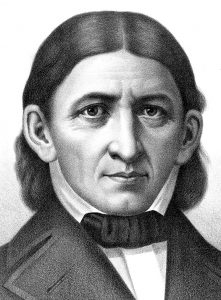 Many people think of Kindergarten as almost a play date. They think of a classroom filled with toys, books, and craft supplies, as well as a playground for recess. Many people think of it as a daycare for working parents, and of course, a place for early childhood development. All these are good things, but this was not the original plan for the creator of Kindergarten, German born Friedrich Wilhelm August Fröbel. He wanted it to be a place that was both ‘a garden for children’, where children meet with environment and also ‘a garden of children’, where they play together and express themselves in a smaller garden world by means of play with their age group. He believed that “children are like tiny flowers; they are varied and need care, but each is beautiful alone and glorious when seen in the community of peers.”
Many people think of Kindergarten as almost a play date. They think of a classroom filled with toys, books, and craft supplies, as well as a playground for recess. Many people think of it as a daycare for working parents, and of course, a place for early childhood development. All these are good things, but this was not the original plan for the creator of Kindergarten, German born Friedrich Wilhelm August Fröbel. He wanted it to be a place that was both ‘a garden for children’, where children meet with environment and also ‘a garden of children’, where they play together and express themselves in a smaller garden world by means of play with their age group. He believed that “children are like tiny flowers; they are varied and need care, but each is beautiful alone and glorious when seen in the community of peers.”
I’m sure this sounds odd to most of us, but when you look at his background, I think you will understand why he felt the way he did. Fröbel had an unhappy childhood with a severe step-mother. He was abandoned and treated in a strict fashion as a child. He got to know what happiness was, when he was living with his uncle’s family while studying at high school. He had a huge desire for education, strong Christian faith and love of nature. He studied mineralogy in Jena,  Germany and architecture at the Berlin’s Humboldt University. Inborn skills of an educator helped Fröbel to realize the failure of teaching system because of its incompleteness and the failure to include the outside world in the educational process. The first kindergarten was established by Fröbel in Bad Blankenburg in 1837. He renamed his Play and Activity Institute to a ‘kindergarten’ two years later in 1840. That Bad Blankenburg Infant school used play, games, songs, stories, and crafts to encourage children’s imagination and broaden their physical and motor skills. “Kommt, lasst uns unsern Kindern leben” Come, let us live with our children’ turned into the catchphrase of the early childhood education.
Germany and architecture at the Berlin’s Humboldt University. Inborn skills of an educator helped Fröbel to realize the failure of teaching system because of its incompleteness and the failure to include the outside world in the educational process. The first kindergarten was established by Fröbel in Bad Blankenburg in 1837. He renamed his Play and Activity Institute to a ‘kindergarten’ two years later in 1840. That Bad Blankenburg Infant school used play, games, songs, stories, and crafts to encourage children’s imagination and broaden their physical and motor skills. “Kommt, lasst uns unsern Kindern leben” Come, let us live with our children’ turned into the catchphrase of the early childhood education.
Friedrich Fröbel also used studying and nurturing plants in a garden for stimulating children’s interest in the natural world. In reality, we can trace the similarities to the Montessori school system and the Pestalozzian consideration of importance to grow up in harmony with nature. Fröbel paid much attention to preparing for  further school education by training the children through the complimentary self expression, creativeness, collective involvement, and motor activity. He considered training of all the vivid faculties: artistic, imaginative, linguistic, arithmetical, musical, aesthetic, scientific, physical, social, moral, cultural, and spiritual, complete growth and harmonious development to be even more important than any kind of knowledge. Fröbel’s kindergarten system flourished globally. Most kindergartens were organized for children of all social classes, ethnic groups and religious believes, Jewish as well as Christian. Fröbel’s vision of kindergarten seems to be so familiar and proper, however it was a fresh and revolutionary look on early childhood education in his time.
further school education by training the children through the complimentary self expression, creativeness, collective involvement, and motor activity. He considered training of all the vivid faculties: artistic, imaginative, linguistic, arithmetical, musical, aesthetic, scientific, physical, social, moral, cultural, and spiritual, complete growth and harmonious development to be even more important than any kind of knowledge. Fröbel’s kindergarten system flourished globally. Most kindergartens were organized for children of all social classes, ethnic groups and religious believes, Jewish as well as Christian. Fröbel’s vision of kindergarten seems to be so familiar and proper, however it was a fresh and revolutionary look on early childhood education in his time.
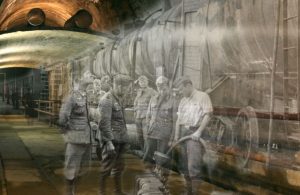
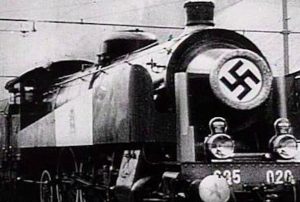 So much is still unknown about the things that Adolf Hitler did, including an apparent “Ghost Train” that was filled with gold and other treasures. According to legend, as the Soviet forces approached in the final days of World War II, an armored train left the city of Breslau (now Wroclaw, Poland) in April 1945 and headed west toward Waldenburg (now Walbrzych). Somewhere along the 40 mile trip, the train and its cargo of gold and other treasures…many of them stolen by the Nazis from Jewish families…vanished into the Owl Mountains, never to be seen again, except in local legend. Stories of the Nazi “Ghost Train” date back some 70 years, although historians haven’t been able to conclusively prove the train ever existed. During the war, Hitler ordered the creation of a network of underground tunnels in the Owl Mountains, which at the time were under German control, as part of a project known as “Riese,” meaning “Giant.” The original rumor of a Nazi train hidden in the mountains came from a Polish miner, who claimed that just after the war, German miners told him they had seen the train being pushed into one of the tunnels.
So much is still unknown about the things that Adolf Hitler did, including an apparent “Ghost Train” that was filled with gold and other treasures. According to legend, as the Soviet forces approached in the final days of World War II, an armored train left the city of Breslau (now Wroclaw, Poland) in April 1945 and headed west toward Waldenburg (now Walbrzych). Somewhere along the 40 mile trip, the train and its cargo of gold and other treasures…many of them stolen by the Nazis from Jewish families…vanished into the Owl Mountains, never to be seen again, except in local legend. Stories of the Nazi “Ghost Train” date back some 70 years, although historians haven’t been able to conclusively prove the train ever existed. During the war, Hitler ordered the creation of a network of underground tunnels in the Owl Mountains, which at the time were under German control, as part of a project known as “Riese,” meaning “Giant.” The original rumor of a Nazi train hidden in the mountains came from a Polish miner, who claimed that just after the war, German miners told him they had seen the train being pushed into one of the tunnels.
In 2015, two anonymous men contacted officials in Walbrzych, a district in southwestern Poland, claiming to know the train’s location and demanding 10 percent of the value of its contents in exchange for leading authorities there. According to Marika Tokarska, an official in the southwestern Polish district of Walbrzych, a law firm representing two men…a Pole and a German, who prefer to remain anonymous…sent her office two letters, offering a description of the train and its contents and claiming to know its location. The documents received from the law firm claim the train is some 490 feet long and loaded with guns, precious metals and other valuables, including up to 300 tons of gold. In exchange for revealing the train’s location, the men are demanding 10 percent of the value of its contents. Although there is much skepticism expressed by historians as to the validity of the men’s claims, authorities in Walbrzych say they will pay the reward if the information turns out to be legitimate. I guess I would too. The men are asking 10% of the total, which could be a huge amount, but not nearly as much as the remaining 90%, so paying them would make sense. As Tokarska told the Associated Press: “We believe that a train has been found. We are taking this information seriously.” Though the men’s knowledge of the train’s contents and their retaining of a lawyer lend legitimacy to their claims, there is still plenty room for skepticism: The first letter from the men’s law firm included several references to local topography suggesting the men might not be as familiar with the area as they claim, and previous searches for the train in recent years have yielded nothing.
Andreas Richter, a German, and Piotr Koper, a Pole, moved in with heavy equipment and dug deep at a site near rail tracks in Walbrzych, following comments by residents who said they had knowledge of the train’s 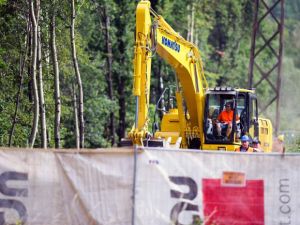
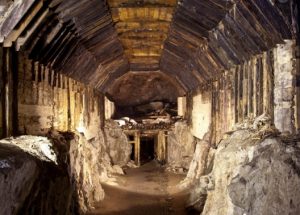 existence. Richter and Koper said that their own tests using earth-penetrating radar confirmed a train was at the site. Nevertheless, after an initial dig, the crew turned up no sign of the “Ghost Train.” Still, they have not given up just yet. There are plans in place to dig again in the very near future. The two men are determined to prove that they have found the real “Ghost Train,” and to claim the 10% share they were promised, it they find it.
existence. Richter and Koper said that their own tests using earth-penetrating radar confirmed a train was at the site. Nevertheless, after an initial dig, the crew turned up no sign of the “Ghost Train.” Still, they have not given up just yet. There are plans in place to dig again in the very near future. The two men are determined to prove that they have found the real “Ghost Train,” and to claim the 10% share they were promised, it they find it.
 We all know about the International Space Station these days, but any previous space stations were not really very well known…at least I didn’t know much about them. The United States and Russia have been in competition for years, and over far more than the space program, but it was one area that they carried on a heated competition over. It seems like one or the other was always a little bit ahead, but there were a few places that Russia definitely beat the United States. One such area was the Space Station.
We all know about the International Space Station these days, but any previous space stations were not really very well known…at least I didn’t know much about them. The United States and Russia have been in competition for years, and over far more than the space program, but it was one area that they carried on a heated competition over. It seems like one or the other was always a little bit ahead, but there were a few places that Russia definitely beat the United States. One such area was the Space Station.
On April 19, 1971, the Soviet Union (Russia) launched Salyut 1 (English translation: Salute 1). It was the first space station of any kind. More stations followed in the Salyut program, and there are parts of that space station program that are still in use on the International Space Station today. Salyut 1 originated as a modification of the military Almaz space station program that the Soviets were developing at that time. After the landing of Apollo 11 on the Moon in July 1969, the Soviets began shifting the primary emphasis of their manned space program to orbiting space stations, with a possible lunar landing later in the 1970s if the N-1 booster became flight-worthy (which it didn’t). I suppose that since the moon landing had already happened, they decided to  focus their efforts on something they could be first at. It was the perfect motivation for the space station program…a desire to one-up the United States Skylab program, which was already in development. The basic structure of Salyut 1 was adapted from the Almaz with a few modifications and would form the basis of all Soviet space stations through Mir.
focus their efforts on something they could be first at. It was the perfect motivation for the space station program…a desire to one-up the United States Skylab program, which was already in development. The basic structure of Salyut 1 was adapted from the Almaz with a few modifications and would form the basis of all Soviet space stations through Mir.
Several military experiments were nonetheless carried on Salyut 1, including the OD-4 optical visual ranger, the Orion ultraviolet instrument for characterizing rocket exhaust plumes, and the highly classified Svinets radiometer. Construction of Salyut 1 began in early 1970 and after nearly a year, it was shipped to the Baikonur Cosmodrome. Some remaining assembly work had yet to be done and this was completed at the launch center. Launch was planned for April 12, 1971 to coincide with the 10th anniversary of Yuri Gagarin’s flight on Vostok 1, but technical problems delayed it until the 19th. The first crew launched later in the Soyuz 10 mission, but they ran into troubles while docking and were unable to enter the station; the Soyuz 10 mission was aborted and the crew returned safely to Earth. Its second crew launched in Soyuz 11 and remained on  board for 23 days. This was the first time in the history of spaceflight that a space station had been manned, and a new record in time spent in space. This success was, however, overshadowed when the crew was killed during re-entry, as a pressure-equalization valve in the Soyuz 11 re-entry capsule had opened prematurely, causing the crew to asphyxiate. After this accident, missions were suspended while the Soyuz spacecraft was redesigned. The station was intentionally destroyed by de-orbiting it after six months in orbit, because it ran out of fuel before a redesigned Soyuz spacecraft could be launched to it. Space stations have come a long way since that first station, but the Salyut 1 will always have the place of honor as the very first one.
board for 23 days. This was the first time in the history of spaceflight that a space station had been manned, and a new record in time spent in space. This success was, however, overshadowed when the crew was killed during re-entry, as a pressure-equalization valve in the Soyuz 11 re-entry capsule had opened prematurely, causing the crew to asphyxiate. After this accident, missions were suspended while the Soyuz spacecraft was redesigned. The station was intentionally destroyed by de-orbiting it after six months in orbit, because it ran out of fuel before a redesigned Soyuz spacecraft could be launched to it. Space stations have come a long way since that first station, but the Salyut 1 will always have the place of honor as the very first one.

